Top 10 Most Significant Land Speed Records of All Time |
| Popular Mechanics By Larry Webster October 1, 2009 12:00 AM |
|
As soon as Karl Benz took his 1886 Patent Motorwagon for its first walking-pace drive, the race for faster cars was on. In this primordial phase of the auto industry, speed was a selling point, an easily identifiable way to establish a car's prowess. As the industry developed, performance remained a forefront of vehicle design, while the quest for all-out speed gradually shifted to race cars. For the first 50 years after Benz's initial drive, record-setting race cars had engines that routed power through drive wheels. But soon after World War II, pioneers like Art Arfons began experimenting with military jet engines. This new breed of speed machines employed the simple reaction force of the engine's high-speed exhaust—imagine a jet with wheels, but no wings. As the Bloodhound SSC team prepares for an onslaught to hit 1000 mph in the next two years, PM looks back at a legacy of extraordinary machines and drivers that came before them. Here we've highlighted 10 of the most significant land speed records in automobile history. |
|
1904 Ford 999It was a typical cold, biting January day near Detroit. Lake St. Clair was frozen, providing the perfect long, flat venue for driving a car as fast as it could go. Henry Ford climbed aboard the 999, a car he designed and built, and reached an astounding 91.37 mph. His record would stand for just one month, but remaining in the record books was the not the goal. Ford hoped to garner some publicity for his fledging car company, the Ford Motor Company. |
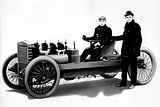 |
1933 Blue BirdRace driver and motoring journalist Malcolm Campbell set numerous records with this car. With a rather astounding 36 liters of displacement, the supercharged Rolls Royce V12 produced over 2000 horsepower. Naturally, finding the traction to harness that power was a major problem, and wheel slip is why the car went "only" 272 mph on Florida's Daytona Beach during its maiden 1933 run. Over the next two years, Campbell improved the car. He modified the bodywork and added dual rear wheels to increase traction. In 1935, on the Bonneville Salt Flats, Campbell became the first man to break the 300-mph barrier. |
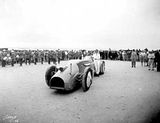 |
1938 Mercedes-Benz W125 RekordwagenThis one-off high-speed special started life as the highly successful Mercedes-Benz W125 Grand Prix race car. The engineers affixed smoother bodywork that enveloped the wheels, and added a 725-hp V12 engine. In January 1938, the Benz rocketed down a stretch of Germany's Autobahn. It's 268-mph speed was not an overall record--the Blue Bird had already cleared 300 mph in 1935--but it is the fastest any car has traveled on a public road. Less than an hour after driver Rudolf Caracciola made his run, one of the greatest drivers of all time, Bernd Rosemeyer, stepped into an Auto Union Streamliner in an attempt to go even faster. Rosemeyer, however, crashed and was killed. |
 |
1964 Green MonsterArt Arfons grew up in rural Ohio, working on the family's feed mill to hone his mechanical aptitude. He and his brother drag-raced and beat legend "Big Daddy" Don Garlits in the late '50s--a sizeable accomplishment. During the next decade, Arfons switched to land speed racing and built a series of jet-powered streamliners. Most of his cars used the name "Green Monster," but this one is the most famous. It set and reset the top-speed record several times during Arfon's battles with Craig Breedlove. On Nov. 7, 1965, Arfons established the top-speed record at 576.5 mph. He beat Breedlove's five-day old record by over 20 mph. But eight days later Breedlove would make another attempt. To find out what happened, click to the next entry. |
 |
1965 Spirit of America Sonic 1As Craig Breedlove climbed aboard the Spirit of America Sonic 1 on Nov. 15, 1965, he must have wondered when the craziness was going to end. In 1963, Breedlove had set the top-speed record at 407.4 mph over a flying mile. Just two years later, Art Arfons reset the point to 576.6 mph--an incredible jump. The Sonic 1 had the same J79 jet engine used in the F104 Starfighter fighter plane and, not coincidentally, in Arfon's Green Monster. On that day in November, however, Breedlove, who was the first to cross 400 and 500 mph on land, also became the first to cross 600 mph. He went 600.6 mph, establishing a record that would stand for five years. |
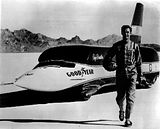 |
1965 Summers Brothers' GoldenrodThe Goldenrod's four fuel-injected Chrysler Hemi engines combined for somewhere around 3000 horsepower. The engines were mounted in line--the two out front powered the front wheels, while the aft engines handled the back axle. In 1965, driver Bob Summers piloted the car to 409.3 mph. That record for piston-powered, wheel-driven cars stood for 26 years. The Goldenrod is now on display at the Henry Ford museum in Dearborn, Mich. |
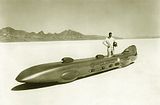 (Photograph courtesy of The Henry Ford Museum) |
1979 Budweiser Rocket CarThe Budweiser rocket car is mired in controversy. Financed by movie director Hal Needham--remember Smokey and the Bandit? --built by William Fredrick and driven by ex-Air Force pilot Stan Barret, the car may or may not have broken the sound barrier in 1979. The answer depends on who you ask. On December 17, 1979, Barret rocketed this missile-shaped car, which employed a liquid hydrogen peroxide jet engine and two solid-fuel booster engines, down Rogers Dry Lake at Edwards Air Force base. Neither the FIA nor the SCTA, the two most widely recognized sanctioning bodies, were present. Allegedly, the car went 739.66 mph, which on a cold day (20 degrees F) would have beaten the sound barrier. But this was a speed briefly measured, based on data from the Air Force's radar installation and accelerometers mounted in the car, not over a timed, measured distance as is the accepted practice. For unknown reasons, another official run was not attempted. The run is generally not recognized, although even Chuck Yeager claimed that photos showed visible shock waves and that the rear wheels lifted off the ground, two signs that the car had gone supersonic. Bystanders didn't report hearing any sonic booms, however. The debate continues. |
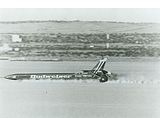 |
1997 Thrust SSCThis is the first car to break the sound barrier unequivocally. Two Rolls Royce Spey turbofan engines muscled this car past that once elusive mark with a combined 50,000 pounds of thrust. The engines burned nearly 5 gallons of fuel every second. Pilot Andy Green averaged 763.04 mph over a mile on Nevada's Black Rock dry lake on October 15, a day after the 50-year anniversary of Chuck Yeager's first supersonic flight. |
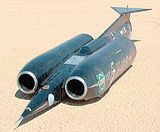 |
2001 Vesco TurbinatorDon Vesco pursued speed records like a pit bull. He's held numerous records over the years, and with this turbine-powered four-wheel drive needle of a car, Vesco claimed the wheel-driven record in 2001 of 458 mph. Vesco passed away the following year, but work continues and the team hopes to break 500 mph in 2010. During its record run in 2001, the car briefly crossed 470 mph--the official figure is a calculated average over a mile--and the team believes that changes to the engine's air intake will result in greater power. |
 (Photograph by Louise Ann Noeth - www.landspeedproductions.biz) |
2004 Buckeye BulletLand speed racing has always been a venue where engineers and backyard tinkerers explore fresh ideas. At Bonneville we've seen supercharged mini bikes and air-powered streamliners. Electric vehicles, like the Buckeye Bullet, are appearing with greater frequency. Amazingly, this car was built by a group of Ohio University students. Some 10,000 C-cell NiMH batteries--the battery pack literally weighs a ton--provide the energy, and a 400 horsepower electric motor drives a five-speed gearbox. In October 2004, the car set an electric-vehicle speed record of 314.96 mph. The record still stands. Up next for the plucky team is a hydrogen fuel-cell streamliner that it hopes to run soon. |
 |
Honorable Mention: The British Steam CarMore than 100 years ago, Fred Marriot drove a Stanley Steamer to an incredible 127.659 mph. A team from Britain broke that record last summer. We're not sure what's more intriguing, the fact that these Brits decided to go after the obscure record, or that the futuristic car was only able to increase the record to 139.84 over a measured mile. |
 (Photograph by Louise Ann Noeth - www.landspeedproductions.biz) |